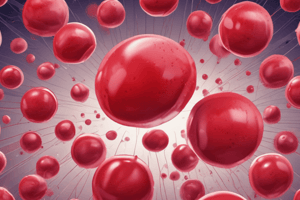Podcast
Questions and Answers
What is the diagnostic value associated with iron deficiency anemia?
What is the diagnostic value associated with iron deficiency anemia?
- D-dimer
- Serum iron
- Platelet count
- MCV (correct)
Which of the following are NOT part of the clinical presentation of anemia?
Which of the following are NOT part of the clinical presentation of anemia?
- Lower extremity edema (correct)
- Mild decrease in exercise tolerance
- Dyspnea requiring supplemental oxygen
- Fatigue
Which of the following is a characteristic physical exam finding in patients with anemia?
Which of the following is a characteristic physical exam finding in patients with anemia?
- Hypoxia
- Increased pulse pressure (correct)
- Decreased pulse pressure
- Hepatomegaly
Which of the following is NOT a type of anemia classified under hypo-proliferative anemia?
Which of the following is NOT a type of anemia classified under hypo-proliferative anemia?
What is the management recommendation for a patient with a hemoglobin value of less than 10 g/dL?
What is the management recommendation for a patient with a hemoglobin value of less than 10 g/dL?
Which of the following is a known acquired cause of blood coagulation disorders?
Which of the following is a known acquired cause of blood coagulation disorders?
What is the diagnostic test used to assess the function of platelets?
What is the diagnostic test used to assess the function of platelets?
Which of the following is a specific diagnostic test for deep vein thrombosis (DVT)?
Which of the following is a specific diagnostic test for deep vein thrombosis (DVT)?
Which of the following is a common management approach for sickle cell anemia?
Which of the following is a common management approach for sickle cell anemia?
Which of the following conditions is typically associated with a lifelong history of bleeding symptoms?
Which of the following conditions is typically associated with a lifelong history of bleeding symptoms?
Flashcards
Anemia
Anemia
A sign of an underlying disorder characterized by a reduction in red blood cells, hemoglobin, or hematocrit.
Hypo-proliferative Anemia
Hypo-proliferative Anemia
Anemia due to disorders that decrease red blood cell production, like iron-deficiency and B12 deficiency.
Non-hypo-proliferative Anemia
Non-hypo-proliferative Anemia
Anemia caused by RBC destruction, such as sickle cell anemia and thalassemia.
Anemia Symptoms
Anemia Symptoms
Signup and view all the flashcards
Diagnostics for Anemia
Diagnostics for Anemia
Signup and view all the flashcards
Coagulation
Coagulation
Signup and view all the flashcards
Inherited Coagulation Disorders
Inherited Coagulation Disorders
Signup and view all the flashcards
Acquired Coagulation Disorders
Acquired Coagulation Disorders
Signup and view all the flashcards
Coagulation Diagnostics
Coagulation Diagnostics
Signup and view all the flashcards
Management of Anemia
Management of Anemia
Signup and view all the flashcards
Study Notes
Anemia
- Anemia is not a disease, but a sign/symptom of an underlying disorder
- Defined as a reduction in red blood cell (RBC) count, hemoglobin concentration, or hematocrit
- Categories based on etiology:
- Hypo-proliferative (RBC production disorders):
- Iron-deficiency anemia
- Vitamin B12 deficiency
- Renal failure
- Marrow failure
- Non-hypo-proliferative (RBC destruction disorders):
- Hemoglobin-related: Sickle cell anemia, thalassemia
- Anemia from blood loss: Acute or chronic
- Hypo-proliferative (RBC production disorders):
- Clinical presentation:
- Gradual onset symptoms appear when hemoglobin < 7.5 g/dL
- Initial symptoms: fatigue, malaise, headache, dyspnea, irritability, mild exercise intolerance
- Severe symptoms: reduced exercise capacity, resting tachycardia, dyspnea requiring supplemental oxygen
- Physical exam findings:
- Wide pulse pressure, midsystolic or pansystolic murmur
- Brittle/spoon-shaped nails, glossitis, angular cheilitis
- Pale palmar creases
- Diagnostics:
- Complete blood count (CBC) with differential (especially mean corpuscular volume, MCV)
- Red blood cell (RBC) morphology
- Reticulocyte count
- Peripheral blood smear
- Hemoglobin electrophoresis
- Serum ferritin, serum iron, total iron-binding capacity (TIBC), transferrin saturation percentage, vitamin B12/folate levels
Blood Coagulation Disorders
- Coagulation is the process transforming blood from a fluid to a gel, stopping blood loss
- Deficiencies in coagulants or anticoagulants can cause bleeding (coagulopathy) or clotting (thrombosis)
- Disorders can be inherited or acquired
- Inherited disorders: Von Willebrand disease, hemophilia A, hemophilia B
- Acquired disorders: Medications (e.g., aspirin, NSAIDs, anticoagulants), organ dysfunction (e.g., liver disease, cancer)
- Clinical presentation:
- Hereditary bleeding disorders: lifelong history of easy bruising, prolonged bleeding with cuts, surgery, or trauma
- Acquired disorders: may appear later in life without history of abnormal bleeding, recent onset of increased bruising, bleeding with trauma, nosebleeds, change in platelet count/clotting test results
- Physical exam: bruises, petechiae, gingival bleeding, epistaxis (nosebleeds), hematomas, blood clots (lower extremity edema, dyspnea, hypoxia)
- Diagnostics:
- Platelet count
- Platelet function analysis
- Peripheral blood smear
- Prothrombin time (PT) or activated partial thromboplastin time (aPTT)
- D-dimer
- Venous ultrasound
- Contrast-enhanced CT chest (preferred), or ventilation/perfusion scans (for patients unable to have CT contrast, allergy, or renal contraindication)
- Management:
- Case-dependent based on underlying etiology, hematologist consultation recommended
Studying That Suits You
Use AI to generate personalized quizzes and flashcards to suit your learning preferences.



